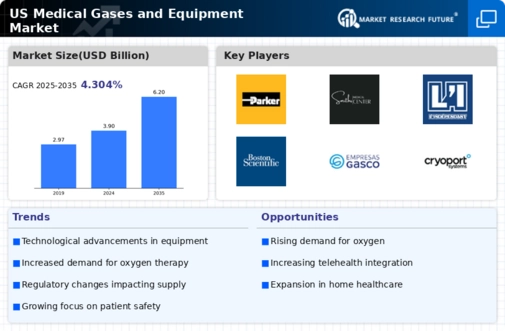The US Medical Gases and Equipment Market is characterized by a variety of players competing to provide essential medical gases such as oxygen, nitrogen, and carbon dioxide, alongside associated equipment like regulators, cylinders, and delivery systems. This market environment is shaped by numerous factors including advancements in technology, regulatory changes, and the evolving needs of healthcare providers. Key players are increasingly focusing on innovation, quality assurance, and supply chain efficiencies to gain a competitive edge.
Furthermore, the impact of strategic partnerships, collaborations, and mergers or acquisitions plays a significant role in determining market dynamics, as companies strive to enhance their product offerings and expand their geographic reach within the healthcare sector.
Parker Hannifin has established a notable presence within the US Medical Gases and Equipment Market by leveraging its robust engineering capabilities and strong reputation for quality. The company is recognized for its wide range of medical gas delivery systems and related equipment, which are designed to meet stringent healthcare regulations and standards. One of Parker Hannifin’s strengths is its commitment to innovation, allowing it to continually enhance its product developments to better serve the evolving requirements of hospitals and healthcare facilities.
Moreover, Parker Hannifin maintains an extensive distribution network and service support, ensuring timely and effective solutions for their customers, which reinforces their position in the competitive landscape.
Air Products and Chemicals is a significant player in the US Medical Gases and Equipment Market, renowned for its comprehensive portfolio that includes medical gases, healthcare equipment, and specialized gas mixtures for medical applications. Their strengths lie in their strong market presence, widespread distribution channels, and constant focus on delivering high-quality solutions tailored to the healthcare industry. Air Products and Chemicals has invested in research and development to enhance their product offerings and improve efficiency in gas delivery systems.
In addition to their innovative products, the company has engaged in several strategic mergers and acquisitions, helping it to expand its capabilities and improve service delivery. This commitment to growth and service excellence solidifies Air Products and Chemicals’ status as a leading competitor in the medical gases segment within the US market.





















Leave a Comment